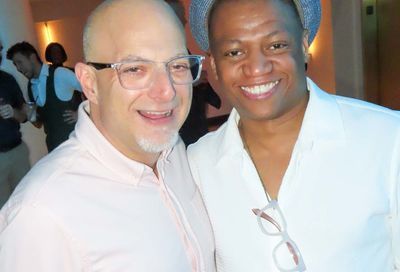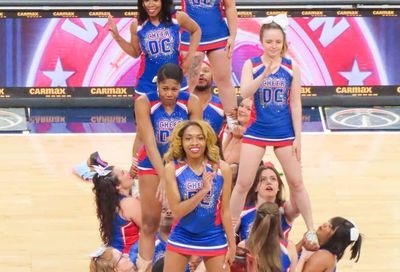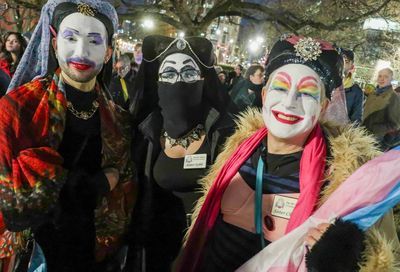Circle Jerks
''The Blue Room'' tackles carnal issues with a modern flair
According to The Politician, there are only two kinds of women: the kind you sleep with, and the kind you marry. Deborah Hazlett has the arduous task of bringing both kinds of ladies to three-dimensional life in David Hare’s sexually-charged The Blue Room. “Freely adapted ” from Arthur Schnitzler’s 1897 La Ronde, The Blue Room is a mature, inter-connected diatribe on all things sexual, featuring two lonely people in a series of ten steamy vignettes.
From prostitution to impotence, infidelity to pedophilia, Hare’s 1998 adaptation tackles eternal carnal issues with a distinctively modern flair. His story liberally follows the lineage of Schnitzler’s brilliant concept: five characters take turns in a round of ten overtly sexual encounters, beginning with the bottom rung of the social ladder and climbing upward, until finally The Aristocrat ends up with the same prostitute we met in the play’s opening scene.
 |
Fueled by Hare’s penchant for sexy, snappy dialogue, and the uncanny ability to affect his writing to multiple genres (he’s Tom Stoppard one minute, David Mamet the next), his contemporary spin opened in London to rave reviews. Add Nicole Kidman to the program under the masterful direction of Sam Mendes, and you’ve made one hot little play in the West End.
But alas, Shirlington isn’t exactly the West End. And although Wendy C. Goldberg’s production at Signature Theatre is directed with her trademark compact style and plenty of superficial panache (it’s a technically beautiful presentation), her staging doesn’t quite generate the same heat or sexual fervor that Hare has infused into his decadent script.
The set and lighting, as designed by Michael Brown, are painstakingly surreal. The talented designer has created a visual wonder that ties in marvelously with Hare’s “full circle ” theme, and his colorful kaleidoscope of lights is gorgeous on stage. Combined with Timothy M. Thompson’s strong, evocative sound design, The Blue Room becomes a window into a world of sexual depravity and encounters of the immoral kind.
Hare explores the humanity in each of his two principals by forcing their hunger on each other. It’s evident they always need something — simple human contact perhaps? — but whether or not they ever fulfill that primal desire is left open to interpretation. One thing is certain: his duets of fools act in earnest, knowing the consequences of their behavior and carrying on in spite of their reckless actions. They are rarely remorseful, and barely surviving.
Hazlett (who could easily pass for a young Jane Curtain) shares the stage with Rick Holmes, a far more versatile actor by comparison. Hazlett isn’t quite sexy enough to fill the stilettos of her lower-class roles. The female Hare has written must embody a diverse range of women from a sexually-liberated actress to a 17-year-old coke-snorting model, and while Hazlett puts forth a noble effort, she is most convincing as the conservative wife of a politico who is so uncomfortable displaying her lingerie that she blurts out defensively, “It’s a body stocking! Madonna wears them. ”
|
Holmes, meanwhile, is fully believable as each of his five characters, from a stifling, cheating husband to a hysterical turn as a frenetic, egotistical playwright. Goldberg also propels a third, silent character into the mix that adds welcome comic relief: Time. Nearly every scene has its own deliberating clock, its purpose to keep the audience informed on how many minutes (and sometimes seconds) pass while the bed is rocking on stage.
While the action in Hare’s cyclical universe takes place over the period of one year, the entire play lasts a swift ninety minutes.
The Blue Room remains a compelling piece of theatre that proffers inspired commentary on the nature of sexual needs versus carnal desires. It’s a raw, dehumanizing and then re-humanizing story that survives its honest treatment. Its message still carries on, adding but another link in the endless chain of human longing.
Support Metro Weekly’s Journalism
These are challenging times for news organizations. And yet it’s crucial we stay active and provide vital resources and information to both our local readers and the world. So won’t you please take a moment and consider supporting Metro Weekly with a membership? For as little as $5 a month, you can help ensure Metro Weekly magazine and MetroWeekly.com remain free, viable resources as we provide the best, most diverse, culturally-resonant LGBTQ coverage in both the D.C. region and around the world. Memberships come with exclusive perks and discounts, your own personal digital delivery of each week’s magazine (and an archive), access to our Member's Lounge when it launches this fall, and exclusive members-only items like Metro Weekly Membership Mugs and Tote Bags! Check out all our membership levels here and please join us today!

















